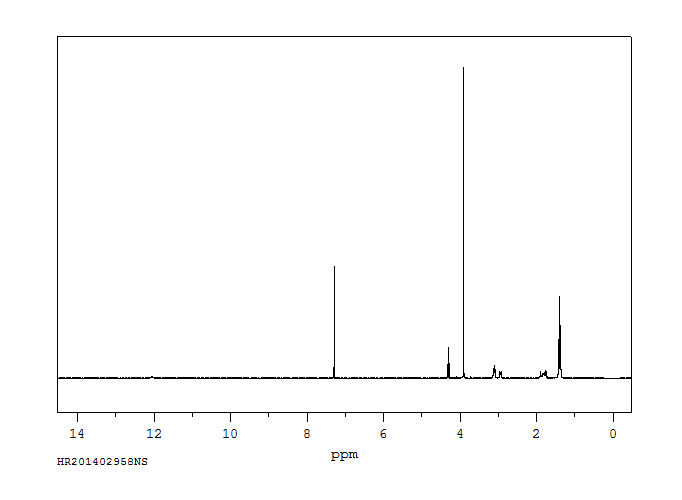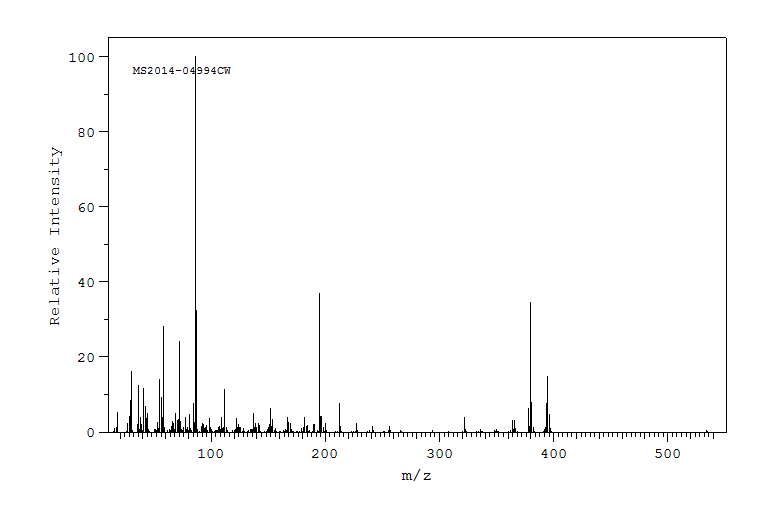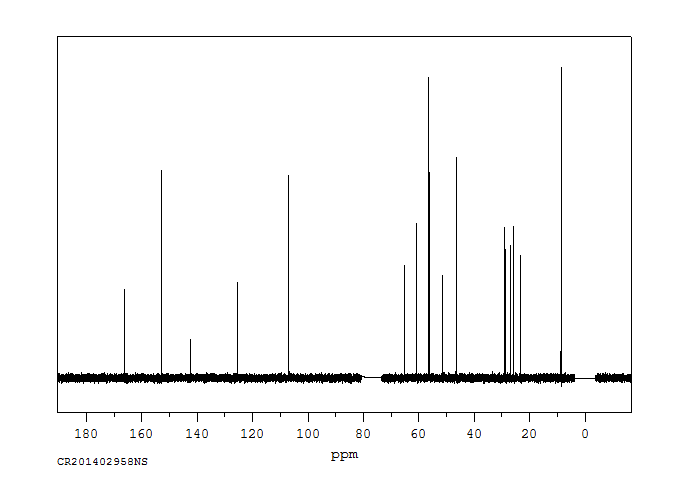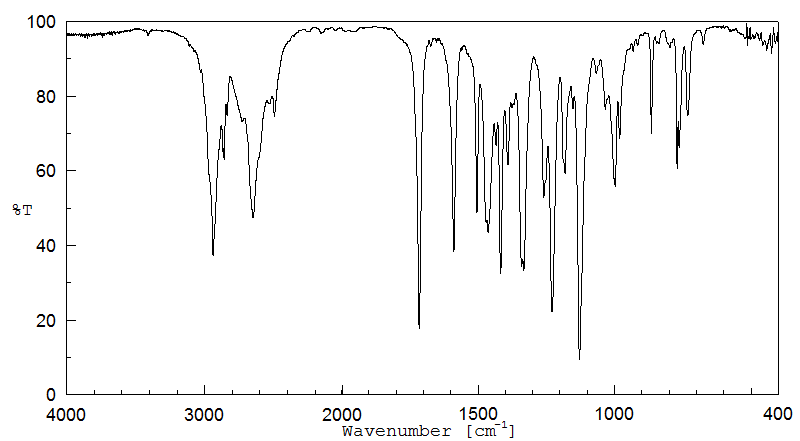3,4,5-三甲氧基苯甲酸(8-二乙氨基正辛基)酯盐酸盐 | 53464-72-5
中文名称
3,4,5-三甲氧基苯甲酸(8-二乙氨基正辛基)酯盐酸盐
中文别名
8-(二乙基氨基)辛基-3,4,5-三甲氧基苯甲酸加氢氯;TMB-8盐酸盐
英文名称
8-(Diethylamino)octyl 3,4,5-trimethoxybenzoate;hydron;chloride
英文别名
8-(diethylamino)octyl 3,4,5-trimethoxybenzoate;hydron;chloride
CAS
53464-72-5
化学式
C22H38ClNO5
mdl
MFCD00012502
分子量
432.0
InChiKey
KFJZVXKPPQIYCG-UHFFFAOYSA-N
BEILSTEIN
——
EINECS
——
-
物化性质
-
计算性质
-
ADMET
-
安全信息
-
SDS
-
制备方法与用途
-
上下游信息
-
反应信息
-
文献信息
-
表征谱图
-
同类化合物
-
相关功能分类
-
相关结构分类
物化性质
-
熔点:94-97 °C(lit.)
-
溶解度:氯仿(微溶)、甲醇(微溶)、水(微溶)
-
稳定性/保质期:
如果按照规格使用和储存,则不会分解,也未有已知危险反应。
计算性质
-
辛醇/水分配系数(LogP):4.59
-
重原子数:29
-
可旋转键数:16
-
环数:1.0
-
sp3杂化的碳原子比例:0.681
-
拓扑面积:58.4
-
氢给体数:1
-
氢受体数:6
安全信息
-
安全说明:S22,S24/25
-
WGK Germany:3
-
海关编码:29225000,2922509090
SDS
Section 1. Chemical Product and Company Identification
8-(Diethylamino)octyl-3,4,5-trimethoxybenzoaCtaetalog
Common Name/
Number(s).
Trade Name
Hydrochloride
CAS# 53464-72-5
Manufacturer
Commercial Name(s)
Synonym
8-(Diethylamino)octyl-3,4,5-trimethoxybenzoate
Hydrochloride
Section 4. First Aid Measures
Eye Contact Check for and remove any contact lenses. In case of contact, immediately flush eyes with plenty of water for at
least 15 minutes. Get medical attention if irritation occurs.
Skin Contact Wash with soap and water. Cover the irritated skin with an emollient. Get medical attention if irritation develops.
Serious Skin Contact Not available.
Inhalation If inhaled, remove to fresh air. If not breathing, give artificial respiration. If breathing is difficult, give oxygen. Get
medical attention.
Serious Inhalation Not available.
Ingestion Do NOT induce vomiting unless directed to do so by medical personnel. Never give anything by mouth to an
unconscious person. If large quantities of this material are swallowed, call a physician immediately. Loosen tight
clothing such as a collar, tie, belt or waistband.
Serious Ingestion Not available.
Section 5. Fire and Explosion Data
Flammability of the Product May be combustible at high temperature.
Auto-Ignition Temperature Not available.
Flash Points Not available.
Flammable Limits Not available.
These products are carbon oxides (CO, CO2), nitrogen oxides (NO, NO2...).
Products of Combustion
Fire Hazards in Presence of Slightly flammable to flammable in presence of heat.
Various Substances
Explosion Hazards in Presence Risks of explosion of the product in presence of mechanical impact: Not available.
of Various Substances Risks of explosion of the product in presence of static discharge: Not available.
Fire Fighting Media SMALL FIRE: Use DRY chemical powder.
and Instructions LARGE FIRE: Use water spray, fog or foam. Do not use water jet.
Special Remarks on As with most organic solids, fire is possible at elevated temperatures.
Fire Hazards Material in powder form, capable of creating a dust explosion.
Special Remarks on Explosion Fine dust dispersed in air in sufficient concentrations, and in the presence of an ignition source is a potential dust
Hazards explosion hazard.
Section 6. Accidental Release Measures
Small Spill Use appropriate tools to put the spilled solid in a convenient waste disposal container. Finish cleaning by
spreading water on the contaminated surface and dispose of according to local and regional authority
requirements.
Large Spill
Use a shovel to put the material into a convenient waste disposal container. Finish cleaning by spreading water
on the contaminated surface and allow to evacuate through the sanitary system.
8-(Diethylamino)octyl-3,4,5-trimethoxybenzoate
Hydrochloride
Section 7. Handling and Storage
Precautions Keep away from heat. Keep away from sources of ignition. Ground all equipment containing material. Do not
breathe dust. Keep away from incompatibles such as oxidizing agents.
Storage Keep container tightly closed. Keep container in a cool, well-ventilated area. Moisture sensitive. Sensitive to light.
Store in light-resistant containers. Refrigerate
Section 8. Exposure Controls/Personal Protection
Engineering Controls Use process enclosures, local exhaust ventilation, or other engineering controls to keep airborne levels below
recommended exposure limits. If user operations generate dust, fume or mist, use ventilation to keep exposure to
airborne contaminants below the exposure limit.
Personal Protection Safety glasses. Lab coat. Dust respirator. Be sure to use an approved/certified respirator or equivalent. Gloves.
Personal Protection in Case of Splash goggles. Full suit. Dust respirator. Boots. Gloves. A self contained breathing apparatus should be used
a Large Spill to avoid inhalation of the product. Suggested protective clothing might not be sufficient; consult a specialist
BEFORE handling this product.
Exposure Limits Not available.
Section 9. Physical and Chemical Properties
Physical state and appearance Solid. (Powdered solid.) Odor Not available.
Taste Not available.
Molecular Weight 432 g/mole
Color White to yellowish.
pH (1% soln/water) Not available.
Boiling Point Not available.
92°C (197.6°F) - 94 C.
Melting Point
Critical Temperature Not available.
Specific Gravity Not available.
Vapor Pressure Not applicable.
Vapor Density Not available.
Volatility Not available.
Odor Threshold Not available.
Not available.
Water/Oil Dist. Coeff.
Ionicity (in Water) Not available.
Not available.
Dispersion Properties
Solubility Not available.
Section 10. Stability and Reactivity Data
Stability The product is stable.
Not available.
Instability Temperature
Conditions of Instability Excess heat, incompatible materials
Incompatibility with various Reactive with oxidizing agents.
substances
Corrosivity Not available.
8-(Diethylamino)octyl-3,4,5-trimethoxybenzoate
Hydrochloride
Not available.
Special Remarks on
Reactivity
Special Remarks on Not available.
Corrosivity
Polymerization Will not occur.
Section 11. Toxicological Information
Routes of Entry Inhalation. Ingestion.
Toxicity to Animals LD50: Not available.
LC50: Not available.
Chronic Effects on Humans Not available.
Other Toxic Effects on Slightly hazardous in case of skin contact (irritant), of ingestion, of inhalation.
Humans
Special Remarks on
Not available.
Toxicity to Animals
Special Remarks on Not available.
Chronic Effects on Humans
Special Remarks on other May cause skin, eye, and respiratory tract irritation.
Toxic Effects on Humans
Section 12. Ecological Information
Ecotoxicity Not available.
BOD5 and COD Not available.
Possibly hazardous short term degradation products are not likely. However, long term degradation products may
Products of Biodegradation
arise.
The product itself and its products of degradation are not toxic.
Toxicity of the Products
of Biodegradation
Special Remarks on the Not available.
Products of Biodegradation
Section 13. Disposal Considerations
Waste Disposal Waste must be disposed of in accordance with federal, state and local environmental
control regulations.
Section 14. Transport Information
DOT Classification Not a DOT controlled material (United States).
Not applicable.
Identification
Not applicable.
Special Provisions for
Transport
DOT (Pictograms)
8-(Diethylamino)octyl-3,4,5-trimethoxybenzoate
Hydrochloride
Section 15. Other Regulatory Information and Pictograms
Federal and State No products were found.
Regulations
California California prop. 65: This product contains the following ingredients for which the State of California has found
Proposition 65 to cause cancer which would require a warning under the statute: No products were found.
Warnings
California prop. 65: This product contains the following ingredients for which the State of California has found
to cause birth defects which would require a warning under the statute: No products were found.
Other Regulations EINECS: This product is on the European Inventory of Existing Commercial Chemical Substances (EINECS no.
258-574-5)
Canada: Not listed on Canadian Domestic Substance List (DSL) or Canadian Non- Domestic Substance List
(NDSL).
China: Not listed on National Inventory.
Japan: Not listed on National Inventory (ENCS).
Korea: Not listed on National Inventory (KECI).
Philippines: Not listed on National Inventory (PICCS).
Australia: Not listed on AICS.
WHMIS (Canada) Not controlled under WHMIS (Canada).
Other Classifications
DSCL (EEC) This product is not classified according Not applicable.
to the EU regulations.
Health Hazard
HMIS (U.S.A.) 1 National Fire Protection
1 Flammability
1 Association (U.S.A.)
Fire Hazard
1 0 Reactivity
Health
Reactivity
0
Specific hazard
Personal Protection
E
WHMIS (Canada)
(Pictograms)
DSCL (Europe)
(Pictograms)
TDG (Canada)
(Pictograms)
ADR (Europe)
(Pictograms)
Protective Equipment
Gloves.
Lab coat.
8-(Diethylamino)octyl-3,4,5-trimethoxybenzoate
Hydrochloride
Dust respirator. Be sure to use an
approved/certified respirator or
equivalent.
SECTION 16 - ADDITIONAL INFORMATION
N/A
制备方法与用途
文献信息
-
Methods and materials for identifying agents which modulate bone remodeling and agents identified thereby申请人:Chatterjee-Kishore Moitreyee公开号:US20060252045A1公开(公告)日:2006-11-09The invention discloses compositions, compounds, apparatuses and methods of using them to study bone mineralization and identify agents that regulate bone mineralization. Methods of using bone mineralization gene profiles and signatures for compound screening and research are also disclosed. Reagents for modulating bone mineralization are provided for both therapeutic and research usage.本发明揭示了用于研究骨矿化和鉴定调节骨矿化的药物的组合物、化合物、装置和使用方法。还揭示了使用骨矿化基因谱和签名进行化合物筛选和研究的方法。提供了用于调节骨矿化的试剂,可用于治疗和研究。
-
Dopamine analog amide申请人:——公开号:US20010056116A1公开(公告)日:2001-12-27The invention involves the formation of a prodrug from a fatty acid carrier and a neuroactive drug. The prodrug is stable in the environment of both the stomach and the bloodstream and may be delivered by ingestion. The prodrug passes readily through the blood brain barrier. Once in the central nervous system, the prodrug is hydrolyzed into the fatty acid carrier and the drug to release the drug. In a preferred embodiment, the carrier is 4, 7, 10, 13, 16, 19 docosahexa-enoic acid and the drug is dopamine. Both are normal components of the central nervous system. The covalent bond between the drug and the carrier preferably is an amide bond, which bond may survive the conditions in the stomach. Thus, the prodrug may be ingested and will not be hydrolyzed completely into the carrier molecule and drug molecule in the stomach.
-
Point mutant mice with hypersensitive alpha 4 nicotinic receptors: dompaminergic pathology and increased anxiety申请人:——公开号:US20020104107A1公开(公告)日:2002-08-01The present invention relates to transgenic animals expressing a hypersensitive nicotinic acetylcholine receptor. Transgenic animals have point mutations in the nucleic acid sequence encoding the &agr;4 subunit of the receptor that result in increased sensitivity to nicotine. Such transgenic animals are model systems for nicotine addiction and certain types of epilepsy.
-
Treatment of neurodegenerative disease申请人:——公开号:US20030060487A1公开(公告)日:2003-03-27In some aspects, the invention relates to treatments for peptide aggregation associated with disease states such as neurodegenerative disease, particularly physiology associated with Alzheimer's Disease, and non-neurodegenerative disease aggregation. Other aspects of the invention provide a variety of novel assays for screening candidate drugs. Yet other aspects of the present invention provide a series of compositions useful for treatment of peptide aggregation associated with disease states such as neurodegenerative disease, as determined from these assays. These compositions can be packaged in kits. Other aspects of the invention relate to the use of these compositions for the treatment and/or prevention of patients susceptible to or exhibiting symptoms characteristic of fibril formation or aberrant protein aggregation.在某些方面,本发明涉及与神经退行性疾病(尤其是与阿尔茨海默氏症相关的生理学疾病)等疾病状态有关的肽聚集以及非神经退行性疾病聚集的治疗方法。本发明的其他方面提供了多种用于筛选候选药物的新型检测方法。本发明的其他方面还提供了一系列用于治疗与神经退行性疾病等疾病状态相关的肽聚集的组合物,这些组合物是通过这些检测方法确定的。这些组合物可以包装成试剂盒。本发明的其他方面涉及使用这些组合物治疗和/或预防易患或表现出纤维形成或异常蛋白聚集特征症状的患者。
-
Ncam binding compounds申请人:Biilmann Christian Ronn Lars公开号:US20050222041A1公开(公告)日:2005-10-06The present invention concerns an NCAM (neural cell adhesion molecule) binding peptide capable of stimulating NCAM signalling and/or interfering with cell adhesion. The compound may be used for the treatment of diseases or conditions of the central and peripheral nervous system.本发明涉及一种能够刺激 NCAM 信号和/或干扰细胞粘附的 NCAM(神经细胞粘附分子)结合肽。该化合物可用于治疗中枢和外周神经系统的疾病或病症。
表征谱图
-
氢谱1HNMR
-
质谱MS
-
碳谱13CNMR
-
红外IR
-
拉曼Raman
-
峰位数据
-
峰位匹配
-
表征信息
同类化合物
(βS)-β-氨基-4-(4-羟基苯氧基)-3,5-二碘苯甲丙醇
(S,S)-邻甲苯基-DIPAMP
(S)-(-)-7'-〔4(S)-(苄基)恶唑-2-基]-7-二(3,5-二-叔丁基苯基)膦基-2,2',3,3'-四氢-1,1-螺二氢茚
(S)-盐酸沙丁胺醇
(S)-3-(叔丁基)-4-(2,6-二甲氧基苯基)-2,3-二氢苯并[d][1,3]氧磷杂环戊二烯
(S)-2,2'-双[双(3,5-三氟甲基苯基)膦基]-4,4',6,6'-四甲氧基联苯
(S)-1-[3,5-双(三氟甲基)苯基]-3-[1-(二甲基氨基)-3-甲基丁烷-2-基]硫脲
(R)富马酸托特罗定
(R)-(-)-盐酸尼古地平
(R)-(-)-4,12-双(二苯基膦基)[2.2]对环芳烷(1,5环辛二烯)铑(I)四氟硼酸盐
(R)-(+)-7-双(3,5-二叔丁基苯基)膦基7''-[((6-甲基吡啶-2-基甲基)氨基]-2,2'',3,3''-四氢-1,1''-螺双茚满
(R)-(+)-7-双(3,5-二叔丁基苯基)膦基7''-[(4-叔丁基吡啶-2-基甲基)氨基]-2,2'',3,3''-四氢-1,1''-螺双茚满
(R)-(+)-7-双(3,5-二叔丁基苯基)膦基7''-[(3-甲基吡啶-2-基甲基)氨基]-2,2'',3,3''-四氢-1,1''-螺双茚满
(R)-(+)-4,7-双(3,5-二-叔丁基苯基)膦基-7“-[(吡啶-2-基甲基)氨基]-2,2”,3,3'-四氢1,1'-螺二茚满
(R)-3-(叔丁基)-4-(2,6-二苯氧基苯基)-2,3-二氢苯并[d][1,3]氧杂磷杂环戊烯
(R)-2-[((二苯基膦基)甲基]吡咯烷
(R)-1-[3,5-双(三氟甲基)苯基]-3-[1-(二甲基氨基)-3-甲基丁烷-2-基]硫脲
(N-(4-甲氧基苯基)-N-甲基-3-(1-哌啶基)丙-2-烯酰胺)
(5-溴-2-羟基苯基)-4-氯苯甲酮
(5-溴-2-氯苯基)(4-羟基苯基)甲酮
(5-氧代-3-苯基-2,5-二氢-1,2,3,4-oxatriazol-3-鎓)
(4S,5R)-4-甲基-5-苯基-1,2,3-氧代噻唑烷-2,2-二氧化物-3-羧酸叔丁酯
(4S,4''S)-2,2''-亚环戊基双[4,5-二氢-4-(苯甲基)恶唑]
(4-溴苯基)-[2-氟-4-[6-[甲基(丙-2-烯基)氨基]己氧基]苯基]甲酮
(4-丁氧基苯甲基)三苯基溴化磷
(3aR,8aR)-(-)-4,4,8,8-四(3,5-二甲基苯基)四氢-2,2-二甲基-6-苯基-1,3-二氧戊环[4,5-e]二恶唑磷
(3aR,6aS)-5-氧代六氢环戊基[c]吡咯-2(1H)-羧酸酯
(2Z)-3-[[(4-氯苯基)氨基]-2-氰基丙烯酸乙酯
(2S,3S,5S)-5-(叔丁氧基甲酰氨基)-2-(N-5-噻唑基-甲氧羰基)氨基-1,6-二苯基-3-羟基己烷
(2S,2''S,3S,3''S)-3,3''-二叔丁基-4,4''-双(2,6-二甲氧基苯基)-2,2'',3,3''-四氢-2,2''-联苯并[d][1,3]氧杂磷杂戊环
(2S)-(-)-2-{[[[[3,5-双(氟代甲基)苯基]氨基]硫代甲基]氨基}-N-(二苯基甲基)-N,3,3-三甲基丁酰胺
(2S)-2-[[[[[((1S,2S)-2-氨基环己基]氨基]硫代甲基]氨基]-N-(二苯甲基)-N,3,3-三甲基丁酰胺
(2S)-2-[[[[[[((1R,2R)-2-氨基环己基]氨基]硫代甲基]氨基]-N-(二苯甲基)-N,3,3-三甲基丁酰胺
(2-硝基苯基)磷酸三酰胺
(2,6-二氯苯基)乙酰氯
(2,3-二甲氧基-5-甲基苯基)硼酸
(1S,2S,3S,5S)-5-叠氮基-3-(苯基甲氧基)-2-[(苯基甲氧基)甲基]环戊醇
(1S,2S,3R,5R)-2-(苄氧基)甲基-6-氧杂双环[3.1.0]己-3-醇
(1-(4-氟苯基)环丙基)甲胺盐酸盐
(1-(3-溴苯基)环丁基)甲胺盐酸盐
(1-(2-氯苯基)环丁基)甲胺盐酸盐
(1-(2-氟苯基)环丙基)甲胺盐酸盐
(1-(2,6-二氟苯基)环丙基)甲胺盐酸盐
(-)-去甲基西布曲明
龙蒿油
龙胆酸钠
龙胆酸叔丁酯
龙胆酸
龙胆紫-d6
龙胆紫










